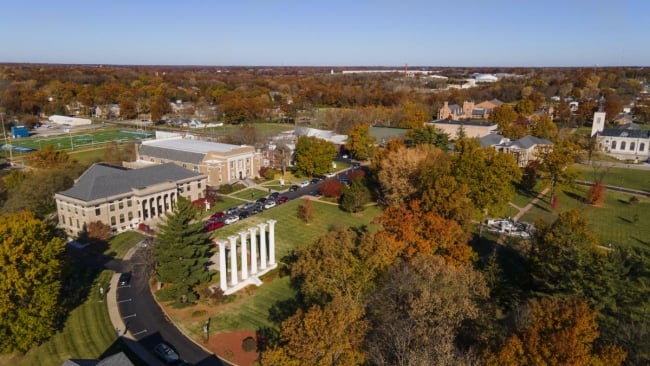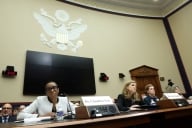You have /5 articles left.
Sign up for a free account or log in.

Westminster College in Fulton, Mo.
Westminster College
Donald P. Lofe will soon hold the fourth and fifth titles he's taken since first being affiliated with Westminster College more than four decades ago: president and chief transformation officer.
Lofe, a 1979 graduate of Westminster, became interim president at the private liberal arts college in Fulton, Mo. last June. Prior to that, he was chair of the Westminster College Board of Trustees for one year and a trustee for nine.
Lofe’s appointment -- and the titles he’s earning and shedding -- stand out for two reasons. As president, he will simultaneously serve as the college’s chief transformation officer -- a role that’s popular in business but that is relatively new to higher education, experts say. Lofe’s transition from board chair to president, which is taking place without a national search process, is also noteworthy because he will not resign his existing seat on the board and will remain on an indefinite leave of absence from that seat through his presidency. The move raises questions about how the new president will avoid potential conflicts of interest.
Westminster’s First Chief Transformation Officer
The chief transformation officer role is new for Westminster, which was founded in 1851 and currently enrolls 585 students. Lofe and the board tacked on the title in order to “clearly reinforce the notion that President Lofe will drive the transformation of Westminster College,” Sarah Backer, a spokesperson for the college, said in an email.
“It involves a change management concept relative to cultural aspects of the institution, its curriculum, facilities and finances,” Lofe said about the role.
Westminster was in decent financial shape heading into the pandemic. It broke even in fiscal years 2018 and 2019 after running a deficit for several years. Enrollment, on the other hand, has declined significantly since the college enrolled more than 1,100 undergraduate students during the 2011-12 academic year.
As chief transformation officer, Lofe will strive to hit several goals that he set with the current board chair, Jim Morton, and the board's governance committee. Lofe declined to share details about the goals, but they include helping to develop a strategic plan, reviewing a master plan of campus facilities to determine what needs to be refurbished in the future, and annual budgeting.
Backer declined to provide information about Lofe’s compensation but noted that the chief transformation officer title doesn’t come with any additional pay.
 Lofe has held similar titles in the business world and believes experience he has in change management will serve him well in the chief transformation officer role. Lofe was a partner and chief risk officer for IBM's global business services division. He’s also served as a chief financial officer and chief administrative officer at several other companies.
Lofe has held similar titles in the business world and believes experience he has in change management will serve him well in the chief transformation officer role. Lofe was a partner and chief risk officer for IBM's global business services division. He’s also served as a chief financial officer and chief administrative officer at several other companies.
Chief transformation officers are new to higher education. The title has been popular in the business world for a number of years and is used to describe C-suite-level executives who lead fast, significant transitions in technology or other business aspects.
A few universities and university health centers currently employ chief transformation officers. For example, Dougie Graham serves as chief transformation officer at University of California Health. Steven Tom serves as senior vice president and chief transformation officer at Laureate International Universities, a for-profit college chain.
The University of Colorado system is looking to hire a chief technology transformation officer. The role will focus on streamlining technology services across the four-campus university system, pushing more efficient technology and implementing a customer relationship management system, said Ken McConnellogue, a spokesperson for the university system.
So far this year, colleges and universities have not shown greater interest in chief transformation officers, but that could change, said Rod McDavis, managing principal at AGB Search.
“We anticipate that there may be a rise in these searches during the upcoming academic year as colleges and universities develop their post-pandemic plans,” he said in an email.
Time will tell if the chief transformation officer role sticks around. Richard Skinner, senior consultant at Harris Search Associates and former president of Clayton State University in Atlanta, is skeptical about its value in higher education leadership.
“In higher ed, changing titles is sort of like putting lipstick on a pig,” Skinner said. “Having somebody who’s an innovation officer or change agent or whatever it is -- that in itself doesn't mean you really are going to change.”
At Westminster, the chief transformation officer role isn’t time limited. At no point will the college’s transformation be decidedly complete.
“It’s a continuous process,” Lofe said. “Transformation or change management can be conveyed or conflated as a restructuring initiative. That’s not what it is. It is a continuous process in that you’re always looking to strive to evaluate where you are, evaluate where you want to go and seek input along the way and take actionable steps.”
From Trustee to President and Back Again?
When former Westminster president Fletcher Lamkin retired last year, the college's Board of Trustees did not conduct a national search process to find its next president.
“Instead of conducting a lengthy and expensive search, then spending months bringing someone up to speed, the board felt it had the right person for the job already in place: a distinguished Westminster grad with years of service to the college, who understands the educational, financial and cultural challenges thoroughly and is deeply committed to the college’s transformation,” said Backer, the college's spokesperson.
The board extended Lofe’s leave of absence from the board indefinitely while he is president. He said he’d consider staying in the role of president beyond when his initial contract expires in June 2024, and he would like to return to the board eventually.
“If the board would so choose, I would very much like to return to the board upon the completion of this role,” he said.
As president, Lofe will be an ex officio, nonvoting member of the board. This is typical -- more than 78 percent of college and university presidents serve as ex officio members of their boards, according to AGB’s 2016 Policies, Practices, and Composition of Governing and Foundation Boards report.
It’s best practice for presidents to serve as nonvoting members of their board, said Merrill Schwartz, senior vice president of content strategy and development at AGB.
“I think the best practice is to serve without vote, because otherwise you are often, as a board member, voting on your own performance and priorities,” Schwartz said. “On those occasions where the president may not agree with the decision of the board, it also removes the problem of having to have voted against your board.”
There’s no limit to the number of members the Westminster College Board of Trustees could appoint, so Lofe’s leave of absence doesn’t take up a board seat that would otherwise be filled. That said, the board doesn’t plan to appoint any additional members to replace Lofe. There are currently nearly 30 active members.
“The board could add an additional position or positions at its discretion, in accordance with its governance policies and bylaws,” Backer said.
Shuffling between presidency and board membership can be a delicate dance, because the two roles have different responsibilities under higher education's long tradition of shared governance. But potential conflicts of interest arise more often in scenarios where a past president becomes a member of an institution’s board, Schwartz said. She doesn’t see a lot of room for concern in Lofe’s case.
“I don't see it as a conflict of interest. It may be challenging to stay in your own lane,” Schwartz said. “I think that allowing the new board chair to grow into their position and chair and run their own meetings and set the agenda is very important. The president can be an ally in that.”








